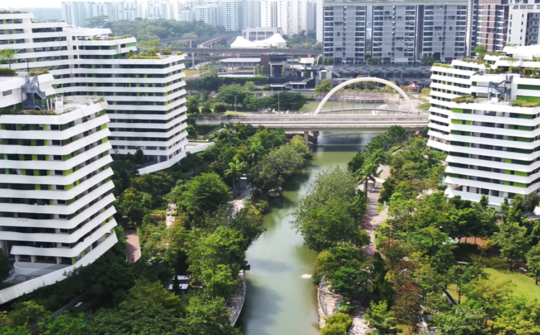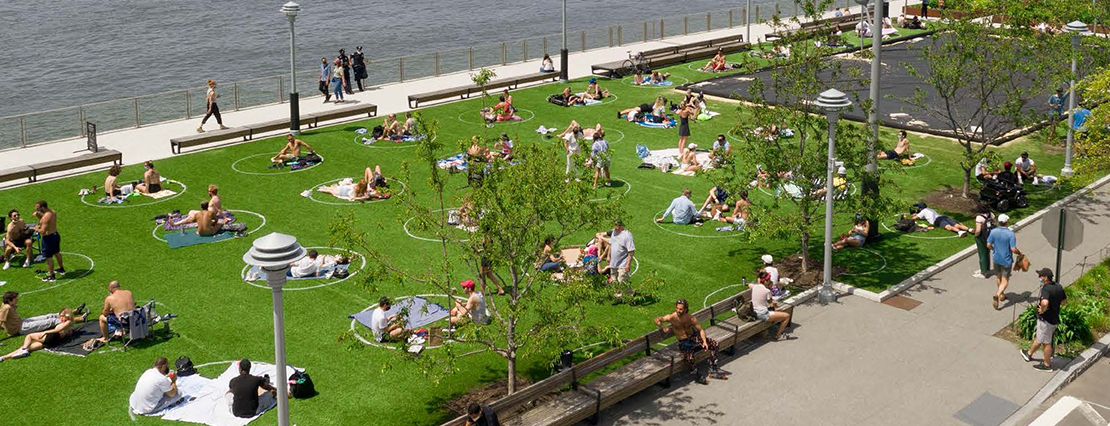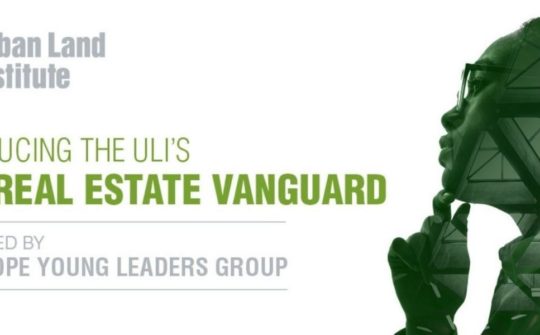
Since the COVID-19 pandemic hit every corner of the globe in spring 2020, cities big and small have had to adapt public space for pandemic use and professionals in every industry have had to transform how and where we work. That’s why ULI set out to research the short- and long-term impacts of the COVID-19 pandemic on real estate and cities, relating not only to work activity but also to space and location. Two examples of this research include a report from the Americas region titled The Pandemic and the Public Realm: Global Innovations for Health, Social Equity, and Sustainability and a report from the Europe, Middle East, and Africa region titled Future of Work 2020: A global real estate players’ point of view.
The Pandemic and the Public Realm details how cities around the globe have rapidly adapted their public spaces to address new challenges and meet new needs in response to COVID-19. With examples spanning four different public space projects, the report is a look book that highlights how cities around the world innovated with low-cost, immediately responsive, and creative interventions that promoted health and social equity. 
By looking at the profiles of 30 cities, the report provides insights into how to create safe, equitable, and desirable public spaces going forward, including the following:
- Cities encouraged outdoor dining, safe shopping, and efforts to ensure that residents could meet all their basic needs within their own neighborhoods.
- By closing streets to car traffic and expanding bike networks, cities reclaimed streets for pedestrian and cyclist use.
- Arts initiatives provided information about COVID-19 safety precautions, attracted people to local business districts, and thanked frontline workers.
- Cities made existing parks safer, such as by drawing social distancing circles, and found creative new spaces to serve as parks, such as by opening golf courses to the public.
“Throughout lockdowns and pandemic-induced changes to the public realm, cities have adapted remarkably to COVID-19 restrictions,” said the report’s authors, Matt Norris, director, and Diana Schoder, senior associate, ULI’s Building Healthy Places Initiative. “We hope that, by seeing what has been possible during a time of crisis, cities will be inspired to continue creating people-centered, healthy public spaces that everyone can enjoy—even after the pandemic is over.” 
Future of Work 2020: A global real estate players’ point of view is the first global report to look at the impact of the future of work on real estate and cities over the next three to five years and foresees a strong focus on flexibility, demanded by both workers and corporates. This increased flexibility is likely to lead to a flight to quality over quantity of office space and a move toward flexible and tailor-made leasing models.
According to EY Consulting Associate Partner Vincent Raufast, remote work makes real estate more critical. “While the total office space is likely to decrease, the quality of real estate will be even more critical. The physical office space will play a key role in preventing a loss of corporate culture, less effective talent management, a higher staff turnover, and a loss of creativity. It will need to meet new demands, including healthy building amenities and more space designed for collaborative work, as well as formal and informal meetings with colleagues.”
Real estate professionals overwhelmingly expect increased remote working, including more home working (96 percent), more remote working away from the home (72 percent), and more use of satellite offices at the edge of cities (67 percent). The resulting ecosystem of workplaces will accelerate a blending of uses between residential, hospitality, and office spaces, and a shift in language from “office” to “workspace.”
The majority of real estate professionals are of the view that more than 60 percent of employees may be spending more than 40 percent of their time working remotely, compared with 20 percent of staff members working 20 percent of their time remotely pre-COVID-19. Nonetheless, respondents continue to see a key role for physical office space in creating a corporate culture (96 percent) and recruiting and retaining employees (93 percent).
Expected impacts on the real estate industry include increased demand for flexible office footprints (96 percent), flexible lease contracts (66 percent), and more widespread use of coworking facilities by large corporate occupiers (60 percent).
Fifty-three percent of respondents anticipate a decrease in the office space needed by their organization, and only 37 percent envisage no change, while increasing the demands for healthy building amenities (94 percent) and more space designed for collaborative work (81 percent). This all may lead to a much faster obsolescence of buildings and future significant repurposing of office buildings.
Finally, the report notes that the impact of the future of work will reach beyond buildings and work activity to communities and cities more broadly. Key changes expected relate to easier access to online public services (93 percent), the need to develop more efficient local supply chains (92 percent), less need to commute (91 percent), and an increasing pressure to focus on social impact, inclusiveness, and health for businesses and people (91 percent).
Explore


